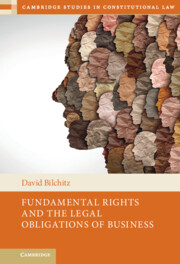Book contents
- Fundamental Rights and the Legal Obligations of Business
- Cambridge Studies in Constitutional Law
- Fundamental Rights and the Legal Obligations of Business
- Copyright page
- Dedication
- Contents
- Figures
- Tables
- Preface
- Acknowledgements
- Table of Cases
- Introduction The Question of Substantive Corporate Obligations for Fundamental Rights
- 1 The Nature and Purpose of the Corporation in Law
- Part I Legal Doctrinal Models for Addressing the Substantive Obligations of Non-State Actors for Fundamental Rights
- 2 The State Duty to Protect Model
- 3 The Indirect Application Model
- 4 The Expanding the State Model
- 5 The Direct Obligations Model
- Part II Towards a Multi-Factoral Approach for Determining the Substantive Content of Corporate Obligations
- Part III The Institutional Implications of the Multi-Factoral Approach
- Bibliography
- Index
2 - The State Duty to Protect Model
from Part I - Legal Doctrinal Models for Addressing the Substantive Obligations of Non-State Actors for Fundamental Rights
Published online by Cambridge University Press: 29 October 2021
- Fundamental Rights and the Legal Obligations of Business
- Cambridge Studies in Constitutional Law
- Fundamental Rights and the Legal Obligations of Business
- Copyright page
- Dedication
- Contents
- Figures
- Tables
- Preface
- Acknowledgements
- Table of Cases
- Introduction The Question of Substantive Corporate Obligations for Fundamental Rights
- 1 The Nature and Purpose of the Corporation in Law
- Part I Legal Doctrinal Models for Addressing the Substantive Obligations of Non-State Actors for Fundamental Rights
- 2 The State Duty to Protect Model
- 3 The Indirect Application Model
- 4 The Expanding the State Model
- 5 The Direct Obligations Model
- Part II Towards a Multi-Factoral Approach for Determining the Substantive Content of Corporate Obligations
- Part III The Institutional Implications of the Multi-Factoral Approach
- Bibliography
- Index
Summary
This chapter considers the ‘state duty to protect’ model developed at the international level which imposes obligations on the state to protect individuals against harms to their fundamental rights by non-state actors. The model attempts to preserve the state-centric nature of international law but, I argue, is not consonant with the legal normative foundations of fundamental rights which are agnostic as to the agents who must realise them. In particular, I show that the model requires understanding what the state must protect individuals against which, in turn, requires determining what the legally enforceable obligations of non-state actors are. Through examining cases of the European Court of Human Rights, I analyse how the Court in fact reasons about the substantive content of such obligations. I show how it lacks a clear analytical framework but references several normative factors and utilises a balancing process which provide the seeds for the multi-factoral approach developed later in the book.
Keywords
- Type
- Chapter
- Information
- Fundamental Rights and the Legal Obligations of Business , pp. 59 - 98Publisher: Cambridge University PressPrint publication year: 2021

